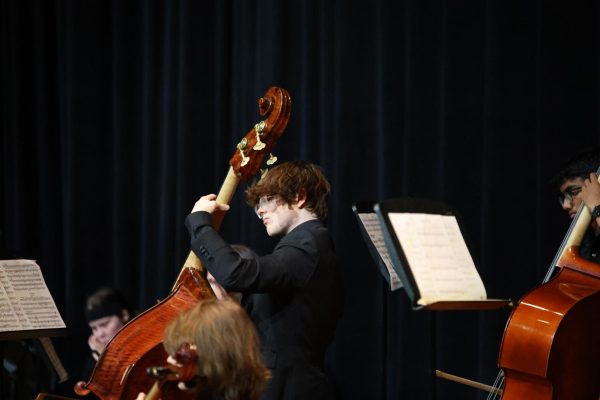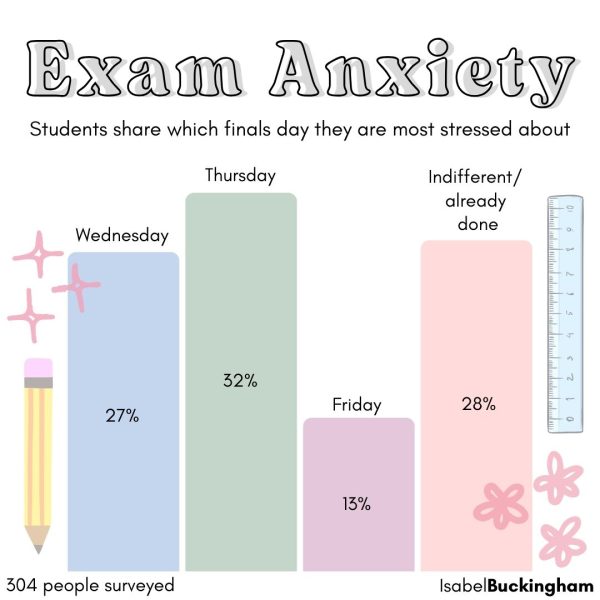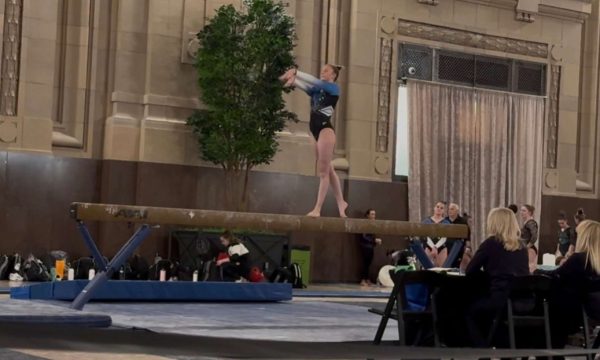Five girls devote time to varsity and competitive cheerleading
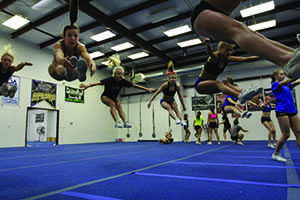
Students are used to seeing cheerleaders as smiling faces chanting in front of the bleachers at a pep assembly. But walking into competitive cheer practice feels more like walking into boot camp. Coaches shout commands from the side: “Eyes up! Move it! ” Stunt groups launch flyers, who spring into the air like shots firing. Athletes leap several feet off the ground, performing stunts that sometimes take an entire summer to perfect. Everything is rapid and there are almost no breaks, no time to stop and rest. But at the same time, the group is organized, disciplined and intense. Each girl wears a mask of determination that covers any signs of pain, because everyone there has a greater purpose: staying strong for the team.
Senior Mikki Wright, sophomore Kate Perrigo and juniors Paige Donovan, Addison Daniel and Katrina Schuster all double as varsity cheerleaders at Southwest and competitive cheerleaders at Kansas City Athletic Cheer (KCAC). But the competitive cheer practice looks nothing like the perfected stunts performed under the lights at Friday night football games. Each group starts its routine, and when someone inevitably falls or is hit, she jumps back up and starts again without hesitation.
“You’re constantly, for three hours a day, pushing your body to its limits,” Wright said. “Even at your most exhausted point, you still have to do your routine full-out; you still have to go for every skill you have; you still have to push yourself and push your teammates. It’s just a lot of mental toughness.”
Since the girls spend anywhere from 15 to 24 hours a week cheering, the teams become pretty close. During the run-through of the routine, whenever one of the girls has a moment of rest, she is screaming “come on, girls!” for her teammates until she is back in again. At one point, one of the stu
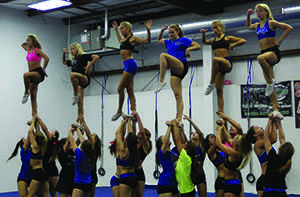
nt groups comes close to completing a routine correctly for the first time. The entire team suddenly erupts with shouts — “You got it!” — as the group continues through the flips. When the group is successful, the room bursts into applause — and then everyone begins working again.
“The hardest part about all-star cheerleading is losing or not putting out the best routine you know your team can do, when everybody wants it so bad,” Wright said. “Letting your coach down is always awful, too. [But] the hardest part I would say for high school cheer is watching one of your teammates get hurt.”
As part of a team, each girl is constantly responsible for someone else’s safety. She could be the one inflicting the pain on her teammate, and if one person goes down, the entire team suffers. But injuries are nearly unavoidable. According to Health News on NPR, “cheering accounts for two-thirds of catastrophic injuries among high school girl athletes.”
In fact, injuries are so common that even the parents don’t give them a second thought. A small room at the front of the KCAC gym serves as a waiting area where spectators can watch the practice from TV screens, since it’s too dangerous to be in the room with the cheerleaders. Here, some of the moms watch the end of practice, chatting about whose daughter broke her neck or needs stitches this week.
To a stranger, this casual smalltalk may come as a surprise. But as Wright said, in cheerleading “every day you get hit at least once,
if not more. You always have bumps and bruises.” While Wright won’t go to the doctor because she doesn’t want to get surgery, she thinks she might have torn ligaments in her wrist. However, with a sport of this level, taking it easy isn’t an option.
“It is what it is,” she said. “Competitive che
er I would say is more mental toughness than physical toughness. You get dropped, you get back up; you get fallen on, you get back up and brush it off. Even if it hurts really bad, you keep going.”
Schuster is no stranger to injuries either. At KCAC she was asked to base with a girl who was much taller than her, so the weight of the girl they were holding was more than her body could handle.
“They [the coaches] made me base a girl, and she was too heavy for me to hold,” Schuster said. “Her weight was more on me, so it just snapped my collar bone in half. [During practice] I sat out and I thought my shoulder hurt, but I didn’t think I broke it. [But] I went to the hospital and it was cracked right down the middle.”
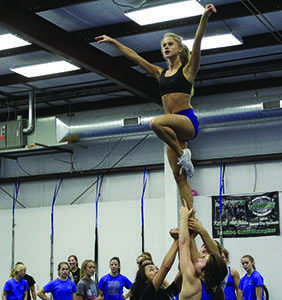
Injuries are largely a result of the difficult skills now required in the sport. High school cheer coach Kelli Lair used to cheer in high school, and she later coached for nine years, including at an all-star gym in college. But she says high school cheerleading has strayed from the cliché.
“There’s more emphasis on skill level and performance, rather than the traditional sideline, support-the-team kind of cheerleading,” she said. “It’s more focused on performing at games, more than just standing there and doing chants.”
Because high school cheerleading now involves more stunts, injuries are common there just as they are in competitive cheer. Over the summer, the girls were practicing without mats when Schuster fell from a height of five feet, knocking her head on the concrete floor. She was unconscious for an hour.
“I was having a seizure while I was completely knocked out,” Schuster said. “I didn’t even know what happened — I still don’t know. I just heard. But I woke up in the hospital, and I had a huge goose egg on the side of my head, and it turned part of my eye purple.”
Although injuries are common in both teams, high school cheer is part of a very different dynamic. At the beginning of the year, each member and parent signs the Cheerleading Constitution, an eight page document outlining the guidelines of high school cheer. For example, absences from scheduled practices for competition routines (during cheer class or after school) result in the entire stunt group of the absent person not being allowed to perform their skills during the routine. In addition, uniform violations result in a demerit and include anything from wearing the incorrect socks to having an unsafe length of fingernails.
The difficult part is maintaining a balance between two teams with equally rigid structure and standards. For example, members of the varsity squad are under no circumstances excused to participate in
any outside activity, including other school sports or competitive cheerleading. But the rules for competitive cheer are just as strict: the gi
rls are required to show up to practice for as much time as possible, even if they just finished cheering on the boys soccer team and there are only two minutes of practice remaining.
“They are held to a standard like every other sports team,” Lair said. “They have consequences and rules they have to follow — sometimes it is even more strict, because they are such a strong image of our school. They are held to a pretty high standard.”
In addition to cheering at sporting events, the high school team also works toward competitions, called showcases, against other schools. On the other side, the competitive team spends the entire year perfecting only one routine. Although they go to several competitions throughout the year, the ultimate goal is to perform their best at the one that really counts — Worlds.
“We’re really superstitious, so we’re working on this year trying not to freak ourselves out before competitions, because there is no reason — it just puts on extra pressure,” Donovan said. “I was never that nervous before other competitions, but when we went to Worlds, I was crying before we went on because I was so scared.”
Last year, the team was shocked when a few mistakes were made during the routine that had never happened before at practice.
“We were all really upset,” Donovan said. “It just kind of broke all of our hearts, because we had spent the whole year working so hard and it just slipped away. But I think that helped us really get a good mindset for this year that we really need to raise the bar and make sure that doesn’t happen again.”
But in general, as Wright said, competitions are what keep the team together.
“Just being able to watch your team push through for two minutes and 30 seconds just for you, and to look by your side and know, hey, they’re pushing through, I can do this too — I would say after doing all of that, you’re physically exhausted, but you’re mentally ready to go and fix whatever messed up, and to practice harder so that it’s more perfect the next time,” Wright said. “After we hit a perfect routine there are lots of tears, because it’s just the best feeling to know that you and the 22 others on your team hit the routine to your best abilities. It’s an indescribable feeling.”
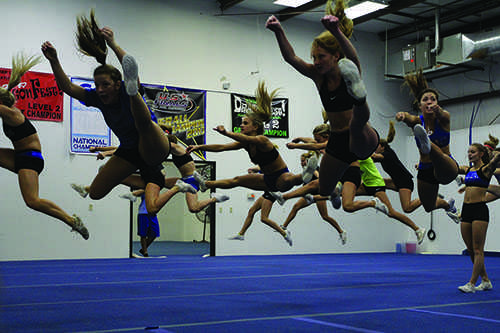
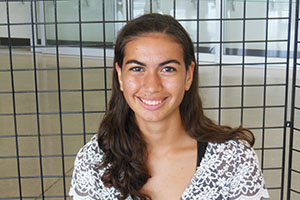
2014 marks Ananda Bhatia's third year in newspaper and first year as editor-in-chief. She is incredibly excited to work with such a talented and hard-working...


